Lesser Known Monuments
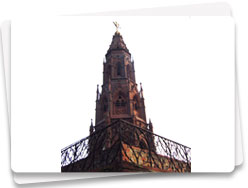
Mutiny Memorial at Northern Ridge near Hindu Rao Hospital.
Mutiny Memorial is located on northern ridge constructed during the British period. The memorial consists of a tapering tower of indifferent gothic design raised on a high base of local hard stone paved with red sand stone. The tower is octagonal externally and is circular internally. The tower was erected in 1863 in memory of the soldiers of the Delhi Field Force who were killed in action or died of wounds or diseases between 30th May and 20th September, 1857.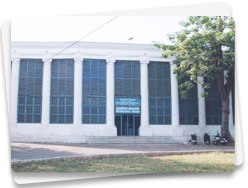
Dara Shikoh Library Building at Kashmere Gate
Dara Shikoh Library Building is popularly known by its name due to its association with Dara Shikoh, eldest son of Shahjahan, the Mughal emperor. It is situated within G.G.S. Indraprastha University Campus at Kashmere Gate. It was once the residence of Ali Mardan Khan, Mughal Viceroy of Punjab (1639 A.D.), later enlarged by the British and used as residency of Sir David Octherlony during 1803 AD. It had also housed a Govt. College and school from 1804 to 1904 A.D. During this period, the building had undergone considerable changes.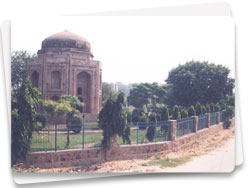
Maqbara Paik opp. G.T.K.Bus Depot.
Maqbara Paik literally means 'tomb constructed for a messenger. It's a Lodhi period monument and constructed in lakhauri brick masonry finished with lime plaster.
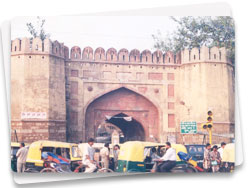
Turkman Gate at Asif Ali Road
The Turkman Gate is so called because it lies near the Tomb of Shah Turkman. It is one of the four existing surviving gates of Shahjahanabad built during the reign of Shahjahan in 17th century.
Pavilion (Baradari) at Qudsia Garden
An ancient building known as Baradari of Quidsia Begum of Mughal period is situated in Quidsia Garden near Kashmere Gate. The Garden which was enclosed by a wall contained a palace, two baradaris and certain other buildings within it. The palace was originally a fort like structure, enclosed by high walls that had burjies in all corners. On 2nd June 1754, the Emperor Ahmad Shah and Queen mother Qudsia Begum were confined here and later executed. During 1857, the British moved their troops here and made heavy bombardment on Kashmere Gate.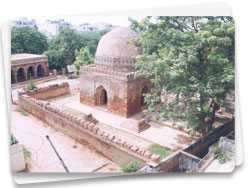
Tomb at Sadhana Enclave
The tomb is a domed structure of Lodhi period (15th Century) situated in the centre of the residential colony. It has arched entrance on the north, south and east while on the west there is a mihrab.
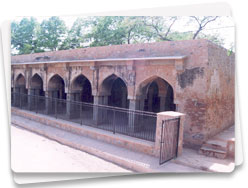
Baradari at Sadhana Enclave
Baradari is an arched hall having seven bays from north to south and three bays deep belongs to Tughlaq period (14th Century) located in the centre of the residential colony.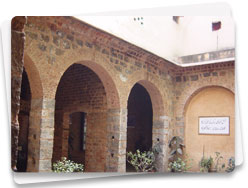
Ghalib Haveli at Ballimaran, Chandni Chowk
A portion of Haveli of Mirza Ghalib located at Gali Qasim Jaan, Ballimaran, Chandni Chowk where the great poet stayed during 1865 to 1869 and spent the last phase of his life.A memorial museum was set up at Mirza Ghalib Haveli showing various facets of Ghalib's life and works and is opened to public on all days from 10 A.M. to 5 P.M. except on Mondays and Gazetted holidays.
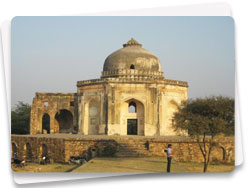
Tomb of Mohd. Quli Khan near Qutub Minar
Muhammad Quli Khan was the brother of Adham Khan. Adham Khan was the son of Maham Anga, the wet nurse of the Mughal emperor Akbar. He rebelled against the emperor and is said to have been killed by being thrown off the parapet. The two brothers were generals in the royal army. Quli Khan's tomb was constructed in the early 17th century.This was the seat of Metcalfe's Dilkusha, the weekend retreat away from the hustle and bustle of the city of Delhi. Charles Metcalfe worked as a negotiator between the East India Company and the Mughal Ruler. It is said that he renovated this place for himself because he wanted to keep a watch on Emperor Bahadur Shah II, who had his Zafar Mahal Palace in Mehrauli to spend his summer time. During the Great Revolt of 1857 the house was ransacked and abandoned.

Bijri Khan's Tomb at R.K.Puram, Sector-III
The tomb is a massive structure constructed of rubble masonry of Lodhi period (15th Century). The dome springs from a sixteen sided drum and is crowned with a red sand stone and marble pinnacle.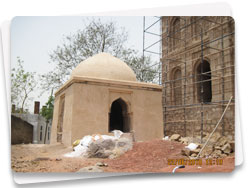
Tomb (Unknown) near Bijri Khan's Tomb at R.K.Puram,Sector-III
The tomb is a domed structure constructed of rubblemasonry with slopping walls during Lodhi period (15th Century). It contains doorways on three sides and mihrab on western side. 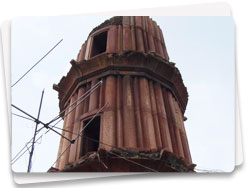
Minar at Hashtsal Village
The Minar is very striking and was built by the Mughal Emperor Shajahan (17th Century). It is a three-storeyed brick-built tapering minar 17m high faced with angular and semi-circular flutings red stone, with a narrow staircase leading to its top. It rises from a two-tired platform.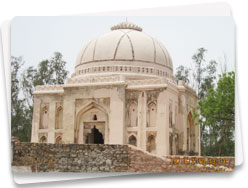
Bara Lao Ka Gumbad & Baradari at Vasant Vihar
The tomb "Bara Lao Ka Gumbad' as it is locally known, and the Baradari inside the DDA Park, Vasant Vihar belongs to the Lodi period. Any other information such as who built these monuments etc is not available.The tomb stands on a high terrace. Over the terrace to the west is a battlement wall mosque containing 15 mihrab recesses. The North West and south west angles of the mosque are strengthened by circular bastions topped by decorative minarets, which are repeated on the central mihrab. The tomb square in plan has arched entrances on the north, south and east while on the west there is a mihrab. The dome springs from a sixteen sided drum ornamented with battlements. Decorative guldastas mark the angles of the drum, which have been destroyed. The parapet and the drum are crowned with battlement / kangura parapets incised in plaster and were originally ornamented with blue tiles that have now completely disappeared leaving only traces at few places. The interior is decorated with inscriptions and incised plaster work.
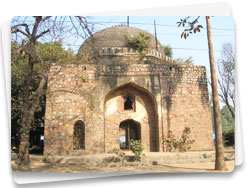
GOL GUMBAD (Near Aman Hotel, Lodhi Road)
The Tomb belongs to the Lodi period. It has a square plan similar to the other Lodi rulers.
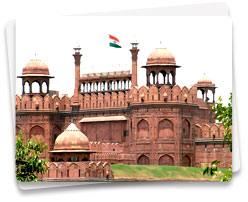
Red Fort
The Red sandstone walls of the massive Red Fort (Lal Qila) rise 33-m above the clamour of Old Delhi as a reminder of the magnificent power and pomp of the Mughal emperors. The walls, built in 1638, were designed to keep out invaders, now they mainly keep out the noise and confusion of the city.








